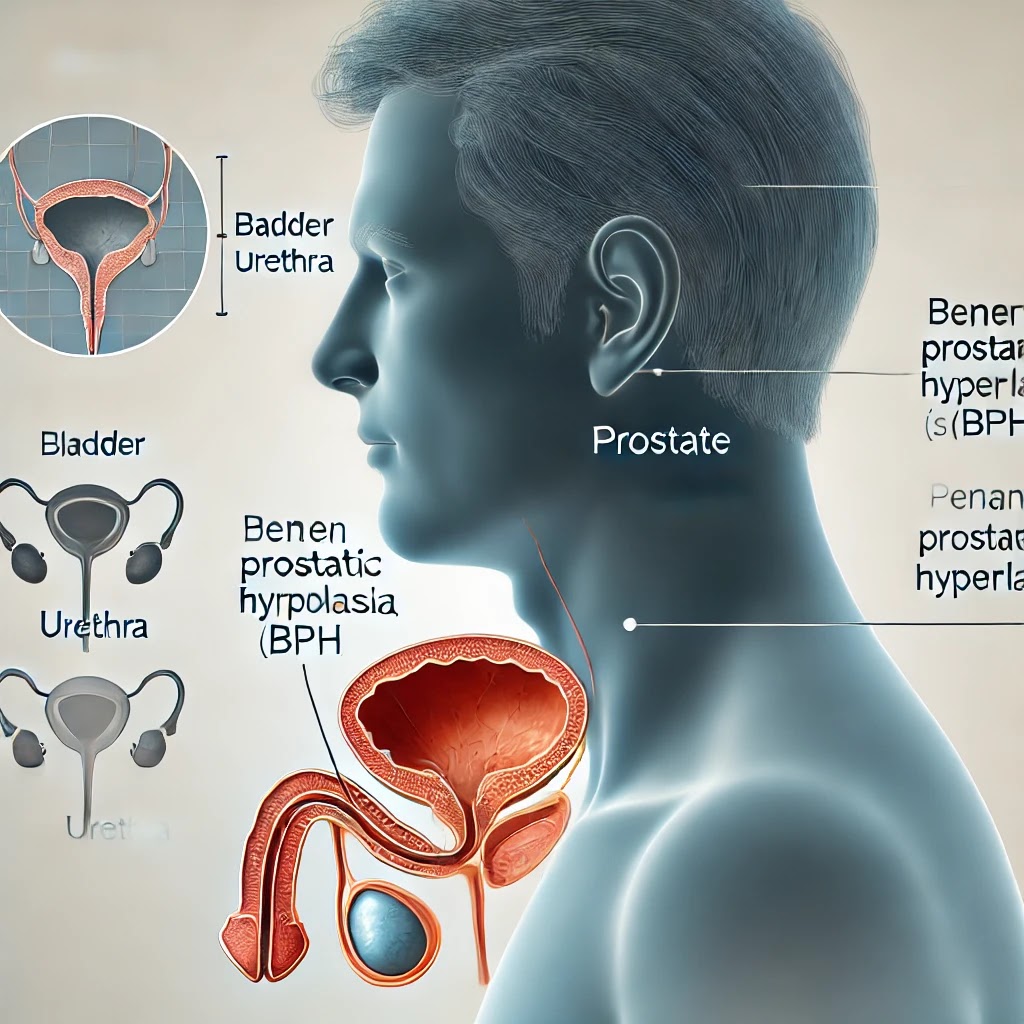Overview
Benign Prostatic Hyperplasia (BPH) refers to a common condition in men over 50, characterized by urinary difficulties due to lower urinary tract symptoms (LUTS). These symptoms often include issues with bladder emptying and frequent urination.Medical Departments
BPH is generally treated by urology or family medicine specialists.Definition
In the past, BPH was defined as an enlarged prostate obstructing the flow of urine from the bladder, causing reduced urine flow. More recently, it is understood as a condition affecting men over 50 with frequent urination (eight or more times a day), nocturia (nighttime urination), urgency (strong and sudden urge to urinate), and difficulty in delaying urination. Other symptoms include interrupted urine flow, straining during urination, and a weak urine stream.Prostate Location
The prostate is located below the bladder and surrounds the urethra, the tube through which urine exits the body.Causes
The exact causes of BPH remain unclear, though age-related changes in hormone levels are thought to be a primary factor. The prostate depends on male hormones like testosterone to grow and function, and the organ tends to shrink if testosterone is no longer produced. Genetic factors also play a role; those with a family history of BPH may have a higher likelihood of developing it.Symptoms
BPH-related symptoms, collectively known as lower urinary tract symptoms (LUTS), include frequent urination (day and night), delayed urination, a weak urine stream, and incomplete bladder emptying. Other symptoms may include urgency, urine leakage, and a sense of incomplete voiding after urination.Diagnosis and Tests
BPH diagnosis involves assessing symptoms, checking prostate size, and evaluating bladder obstruction. Tests may include:1. Medical History and Physical Examination
A doctor will review the patient’s history and perform a physical examination, including a digital rectal exam (DRE) to feel the prostate and detect abnormalities.2. Urinalysis
A urinalysis checks for blood or infection in the urine.3. PSA Test
The Prostate-Specific Antigen (PSA) test measures PSA levels, which can be elevated in cases of prostate enlargement or prostate cancer. Typically, a PSA level below 4 ng/mL is considered normal.4. Uroflowmetry
This test measures the speed and volume of urine flow, helping evaluate urinary obstruction. A flow rate below 15 mL/s suggests potential obstruction.5. Residual Urine Test
This test assesses how much urine remains in the bladder after urination, which may indicate poor bladder emptying due to BPH.6. Urodynamic Testing
This advanced test checks bladder function and obstruction by measuring the pressure within the bladder during urination.7. Symptom Questionnaire
Patients complete an internationally recognized symptom score questionnaire to quantify the severity of their symptoms and guide treatment options.Treatment Options
Treatment depends on symptom severity and can range from lifestyle adjustments to surgery.1. Watchful Waiting
Mild symptoms may be managed by monitoring the condition over time, along with lifestyle changes such as avoiding caffeine and alcohol, and regulating fluid intake.2. Medications
Alpha-blockers such as tamsulosin or alfuzosin relax the prostate muscles to improve urine flow. 5-alpha-reductase inhibitors like finasteride can shrink the prostate by blocking hormone effects. These medications can reduce the need for surgery but may have side effects such as dizziness and sexual dysfunction.3. Herbal Remedies
Although some herbal supplements have been used to treat BPH, their effectiveness remains controversial, and they are not recommended in standard medical practice.4. Surgical Procedures
For more severe cases, surgery may be required:Transurethral Resection of the Prostate (TURP) is the most common surgery, where parts of the prostate are removed through the urethra. It has a high success rate but may cause side effects like bleeding or sexual dysfunction.
KTP Laser Therapy uses lasers to vaporize prostate tissue, with minimal bleeding. While still under evaluation, it shows promising results.
Prostatectomy involves removing larger prostates through open surgery, often used when TURP is not feasible.











0 Comments